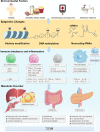Inflammation-Related Epigenetic Modification: The Bridge Between Immune and Metabolism in Type 2 Diabetes
- PMID: 35603204
- PMCID: PMC9120428
- DOI: 10.3389/fimmu.2022.883410
Inflammation-Related Epigenetic Modification: The Bridge Between Immune and Metabolism in Type 2 Diabetes
Abstract
T2DM, as a typical metabolic inflammatory disease, is under the joint regulation of environmental factors and genetics, combining with a variety of epigenetic changes. Apart from epigenetic changes of islet β cells and glycometabolic tissues or organs, the inflammation-related epigenetics is also the core pathomechanism leading to β-cell dysfunction and insulin resistance. In this review, we focus on the epigenetic modification of immune cells' proliferation, recruitment, differentiation and function, providing an overview of the key genes which regulated by DNA methylation, histone modifications, and non-coding RNA in the respect of T2DM. Meanwhile, we further summarize the present situation of T2DM epigenetic research and elucidate its prospect in T2DM clinical diagnosis and treatment.
Keywords: DNA methylation; histone modifications; inflammation; macrophages; non-coding RNA; type 2 diabetes mellitus (T2DM).
Copyright © 2022 Ding, Gao, Chen, Zhang, Hu and Zhao.
Conflict of interest statement
The authors declare that the research was conducted in the absence of any commercial or financial relationships that could be construed as a potential conflict of interest.
Figures


References
Publication types
MeSH terms
LinkOut - more resources
Full Text Sources
Medical

